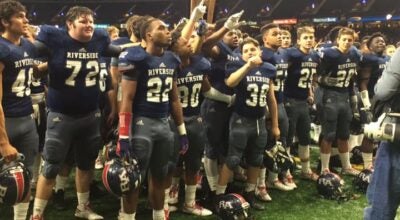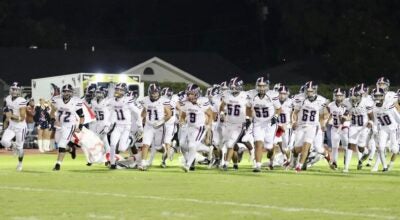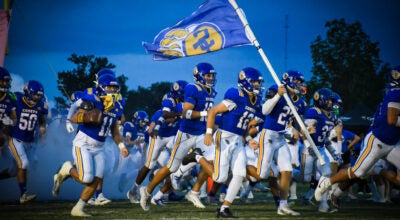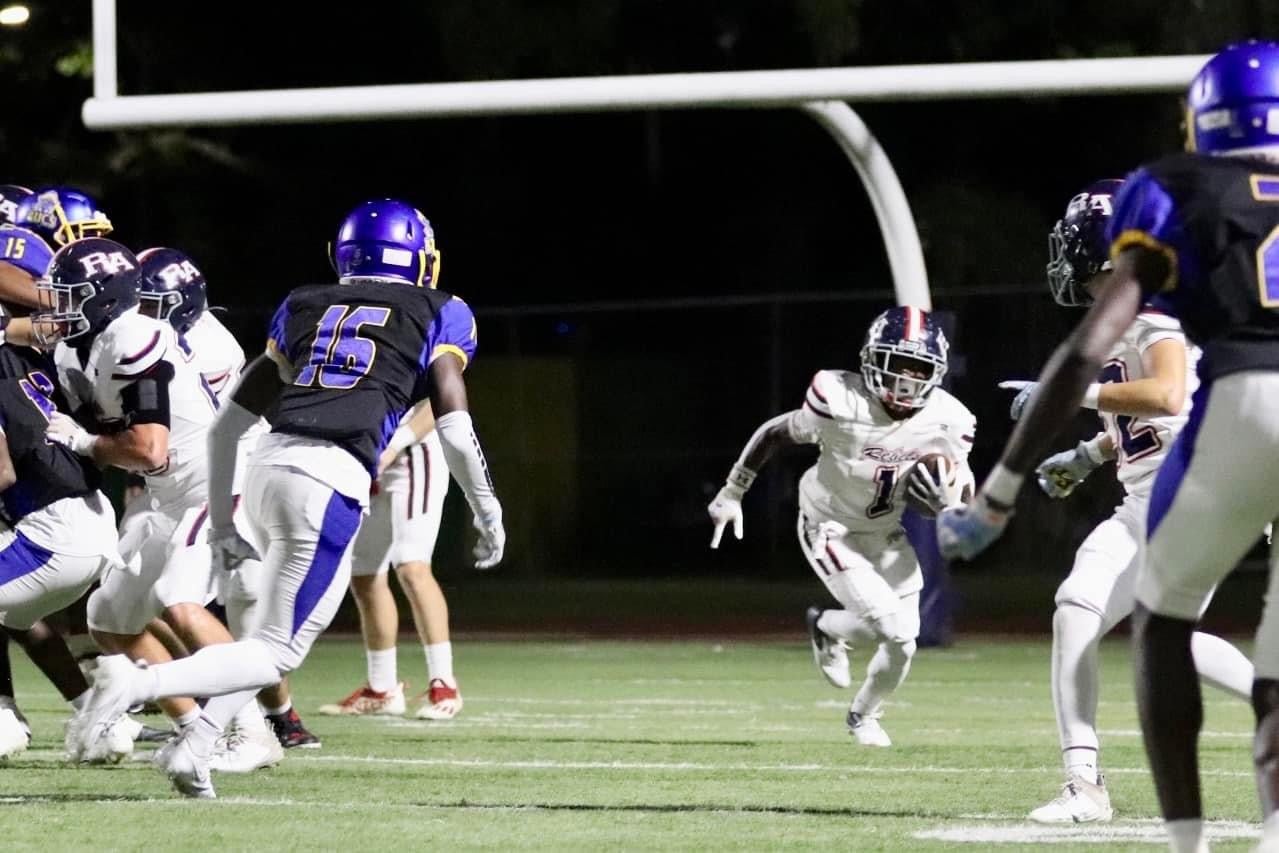Recruiting more than meets the eye
Published 12:00 am Wednesday, January 19, 2000
MICHAEL KIRAL / L’Observateur / January 18, 2000
LAPLACE – A local athlete sitting at a table in his school, signing the national letter of intent and scholarship papers with the college of his choice. The cap of that college being placed on his head. If the recruit is anationally-known one, television lights being flashed in his eyes while a reporter interviews him about his choice.
Elsewhere, there is a college coaching staff waiting for that letter of intent. Fans of the college checking the internet to see who has signed oris attending a recruiting party.
Those are the images most commonly associated with National Signing Day, Feb. 2 this year. But what is less commonly known is the long, tediousprocess – the watching of game films, evaluation of talent, compilation of lists, in-house visits, weekly phone calls and staff meetings – that leads up to that big day. St. Charles Catholic head football coach Frank Monica,who spent years recruiting for Tulane University, compared it to beating on a rock.
“Recruiting is a grind,” Monica said. “It comes down to all the little timecalling on the phone, little notes dropped on him and the personal time you have spent with him. But you have got to have something to sell.”Recruiting may be the most important aspect of any college program. Thebest programs – the Florida States, Floridas, Nebraskas and Penn States – usually are perennial Top 10 finishers in the recruiting polls as well.
“Recruiting is the lifeline to any good program in college,” Monica said.
“You’ve got to have players and that’s when recruiting comes in.”And the job is not getting any easier. In the past, only the high school andcollege staffs along with a few recruiting services knew much about a prospect. With the coming of the internet and more extensive coverageabout recruiting, now almost any one can access information about a particular recruit. There are a number of web sites devoted to recruiting,detailing everything from a recruit’s weight and height to his strengths and weaknesses as a player.
“It’s becoming very intense,” Lutcher head football coach Tim Detillier said. “With the added pressure on recruiting and getting so many recruits,it’s becoming a win at all costs attitude in some situations.”What is also changing is what is discussed when a recruiter meets a player. Whereas in the past a recruiter may have focused on the virtues ofhis program, now a lot of focus is what’s wrong with the other programs that are recruiting that player.
But the first thing that is usually discussed is academics. Withscholarships being limited to 85 per program, teams can ill afford to take chances with its recruits. Both Detillier and East St. John head coachRonnie Stephens agreed that emphasis on academics is another big change in the process.
“Academics is so important,” Stephens, sitting in his office in the East St. John field house, said. “Recruiters used to come here first. Now they goto the counselor first.”The recruiting process usually begins in the player’s junior year, one reason why many high school coaches recommend that they players begin taking the ACT early.
“They have time in case they don’t make it,” Stephens said. “The quickerthey get qualified, the better it is for the athlete and for the recruiter.”Of course, how talented a player is will also play a part in whether the college will continue to go after a player with borderline grades or test scores.
“If it’s close and they really want them, they will go after them,” Detillier said. “If the player is borderline athletically, they might notpursue them as much.”That is definitely true at the junior college level since Proposition 48 has been enacted, according to St. James head coach Rick Gaille.”It’s certainly made a big difference at the junior college level,” Gaille said. “Junior colleges are now recruiting some of the same schools asDivision I schools are.” The first step in the process begins with the mailing out of preliminary cards in January or February for the next year. High school coaches fill outthe cards on possible prospects, listing what division of college football he believes the player will best perform at, his GPA and his vital statistics. Those lists are also mailed to recruiting services which areusually used by out-of-state institutions to get information on a player.
From those lists, a college recruiting staff will put together a master list on players it wants to focus on. The coaches will then watch films onthose players, paring down their lists or adding other players to them.
Getting their players names out is the first major role that the high school coach plays. Riverside head coach Mickey Roussel has a coach on hisstaff that may make up to 50 tapes just on one player.
“As a high school coach, you try to sell your player,” Roussel said. “Youmake highlight films, make decisions on what universities they can play at. But the players get the scholarships, not the high school coach. Theyare looking at the player. They might take the program into considerationbut the player has to perform.”Establishing credibility with the recruiters, such as giving a player’s true height and weight and time in the 40, is another factor that high school coaches have to take into consideration. A coach should also only tout hisplayer if he truly feels he will be able to compete at the next level.
“You want to be very up front and honest,” Detillier said of dealing with recruiters “You want to have a relationship with them. You want to be thebest salesman for your kids and have a good reputation. My kids know Iwill do anything for them but the recruiters also know I’m a straight shooter.”Hahnville head coach Lou Valdin agreed. Valdin had a reputation of gettingplayers to the next level during his time at East St. John. Kerry Watkins,Greg Gathers and Corey Sewell are among those players who played under Valdin who are currently playing major college football.
“If the kid has given time to your program, you owe it to them to help get them exposure and get them eligible,” Valdin said. “But you also want tobe honest with the college coaches about the player’s ability.”During the season, recruiters can call a prospect once a week, usually on Wednesday nights. For a highly recruited player like East St. John’s Roy DelWilliams, it can become a bothersome process with the phone constantly ringing. Williams advises future recruits to get used to it.”Look to people to people to be calling you up a lot and taking you out of class,” Williams said.
Valdin for one would like to see that part of the process stopped during the season.
“It’s important for the coaches to know the kids they are offering scholarships to,” Valdin said. “Let them talk to the kids during the springwhen there is no pressure on them. They have enough to worry about withschool and the season without having to worry about coaches calling them during the season.”After the season is completed, the recruiting really heats up. Coachesmake visits to the school and to the players’ homes. There, they discusseverything from academics to the recruit’s future plans.
“Do you want to visit, what’s your GPA, what did you make on the ACT, are you interested in the school,” Riverside all-State offensive lineman Joe Trosclair said on what was discussed when he met with recruiters.
From these visits, the athletes themselves start planning their official visits, those paid for by the school. Each athlete is limited to five officialvisits.
Destrehan all-State offensive lineman Jeremy Parquet is one local recruit who has made a visit, traveling to Southern Mississippi earlier this month.
Senior offensive lineman Shedrick Blackmon was Parquet’s host player for the visit, showing him around the campus.
“You go there and they feed you good and treat you nice,” Parquet said.
“They bring up school first. That’s the most important thing. They ask youabout your grades first. Then they ask what’s going on in the recruitingprocess.”An official visit may be one of the few times the recruit will get to see the head coach of the college face to face. Head coaches can make only onevisit to a recruit making the role of the recruiting staff that much important. Monica said a good recruiting coach will be relentless but hasto remember not to bombard a prospect to the point that he dodges the recruiter.
This is another time that the high school coach can play a big part in recruiting, giving the player advice about the process. But Stephens saidthe one thing the coach should not do is tell the player where to go.
“It’s a big decision for the athlete and his parents,” Stephens said. “I kindof sit back and answer questions they might have. I try to do what’s bestfor the athlete. I tell them they should go where they can go and be takencare of academically. But the decision of where they should go, that’s notmy job. That’s between the athlete and his parents.”Monica also advises his players to be cautious in the process.
“I tell them to ask questions about what is going on,” Monica said. “Talkto the players at the university. Attend practices and visit the school.Have an idea about the academic schedule and the daily schedule because it can become a four-year grind.” Because of the grind of the recruiting process can often wear thin, another new phenomenon has popped up – early recruiting. West St. John’s DonrielLouis (LSU) and Evangel’s Brock Berlin (Florida) were two examples of recruits committing early this year. Monica said one reason for this newtrend is the development of summer camps that let schools have early looks at prospects and vice versa.
“It can be overbearing,” Stephens agreed. “That’s why more arecommitting early. If there’s no doubt where you are going, it’s not a baddecision to do it early. If you are not sure, it’s best to take visits.”Not that commitment is binding. Monica can tell stories of recruitschanging their minds right up to signing day.
“The school’s bound to the player more than the kid is bound to the school,” Monica said of the situation if a school offers a player a scholarship.
But that scholarship can also be pulled. Monica noted that a recruiter inone area is just one of nine coaches recruiting for a school. Not only doeshe have to sell the prospect to the head coach but also to the position coach. And with the limitations on scholarships, there are times thescholarship will need to be pulled just because of numbers. But Monicasaid that the recruiter should always call to explain the situation.
Another trend that has developed over the recent decades is that recruiting is becoming more a national process. Because Louisiana isgetting a reputation for football talent, especially at the skill positions, more and more out-of-state schools are making the trip to the Bayou State.
“In our area, a number of schools are getting out on the road and coming here from all over the country,” Gaille said. “We’re getting recruitersfrom Virginia, Florida and Massachusetts. More and more people arecoming through here.”Stephens noted the changes when he coached at Northeast Louisiana.
“You have to go up against the best programs in the nation,” Stephens said.
“It’s very competitive. You’ve got to go where the athletes are and rightnow we are competing in the No. 1 state where athletes can play at thenext level. There are a lot of good high school football players in thisstate.”But Monica said there are always risks about going outside your state.
“Your bread-and-butter has to be inside the state,” Monica said. “To gooutside the state, it has to be an outstanding player. Look for a great one,a player that can play on Sundays.”Monica, along with Roussel, would like to have the process shortened with an early signing period in December.
“Don’t make it last as long, Roussel said. “Don’t prolong it.”Roussel would also like to see the number of scholarships increased back up to 95-100 to give more opportunities for players. He also would like tosee Louisiana get more Division II and III programs as well as junior colleges.
Valdin said he would like to see some of the restrictions on college coaches lifted, noting that coaches used to be able to see more games than they can now. Gaille agreed, saying that too many coaches take game filmto heart.
“It’s an inexact science to begin with,” Gaille said. “I would like to seecollege coaches do a more effective personal job in evaluation. “Before,we used to just send game tapes. Now, what we do is send highlight tapes.They want to do most of the evaluation in office. I like to see collegesthemselves get more personally involved in seeing players play and in doing evaluations.”Of course, there are no guarantees that a player will pan out, no matter how much evaluation is put in. When he was a coach at Tulane, Gaille saidhe tried to evaluate the true potential of what a player would be. Gaillenoted that a 19-year-old might have reached his full potential in high school while a 17-year-old who was not as good in high school might have greater potential.
“I did a good bit of time in projecting how much further along a player would go,” Gaille said.
And like anything else, the chances of finding the players to fit your system depended on the amount of preparation put in.
“Recruiting is an opinion,” Monica said. “You can improve your chances bydoing your homework and networking.”
Return To Sports Stories
Copyright © 1998, Wick Communications, Inc.
Internet services provided by NeoSoft.
Best viewed with 3.0 or higher





